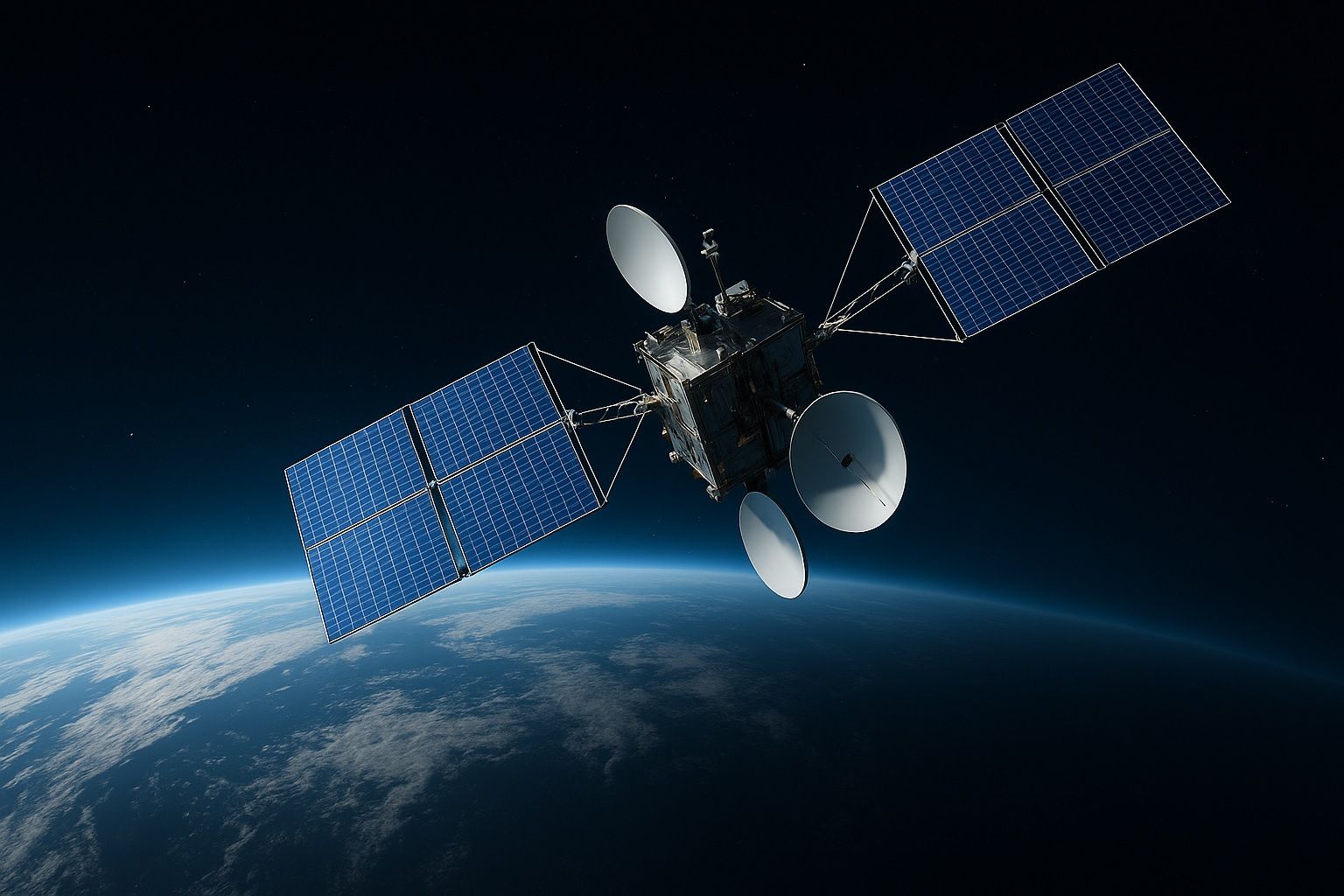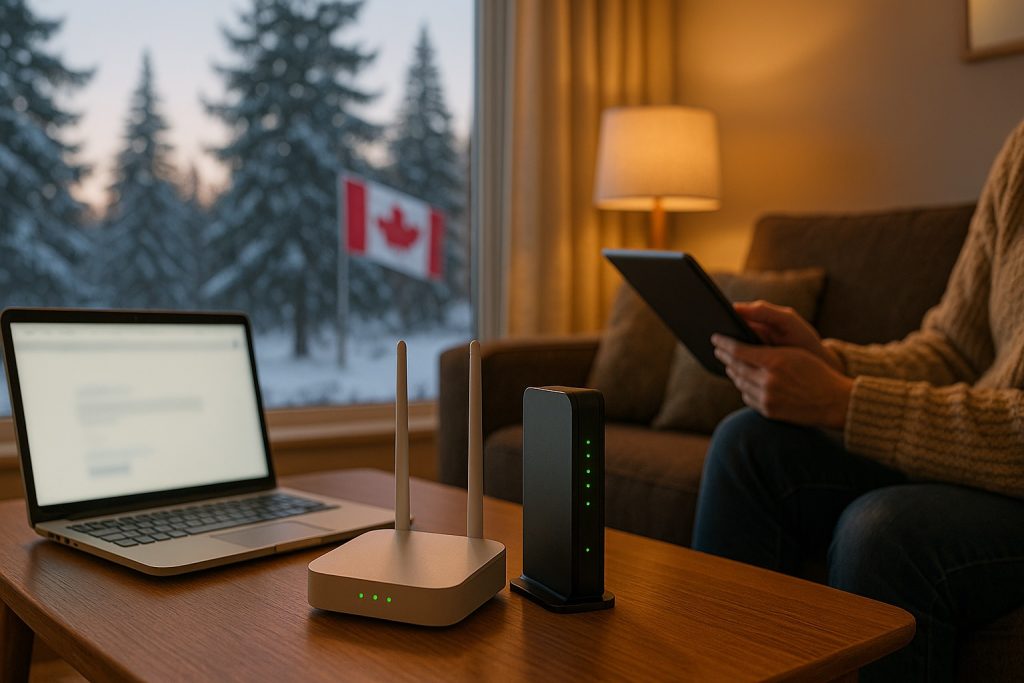- Geostationary orbit sits at about 35,786 km above the equator and completes a sidereal day (~23h56m), so satellites appear fixed over one longitude; Arthur C. Clarke popularized it in 1945, giving the region the nickname the Clarke Belt.
- A GEO satellite remains stationary relative to the ground, allowing ground antennas to point at a fixed spot without tracking.
- Three GEO satellites spaced roughly 120° apart can provide near-global coverage, excluding polar regions.
- Syncom 2, launched in 1963, reached a geosynchronous orbit with a slight inclination, while Syncom 3, launched in 1964, was placed over the equator with zero inclination and appeared stationary.
- Intelsat I (Early Bird) was launched in April 1965 as the first commercial GEO satellite enabling regular telecommunications between Europe and North America.
- Anik A1 (1972) was the first domestic GEO communications satellite, followed by Westar 1 (1974) as the first American domestic commsat.
- ATS-6, launched in 1974, was the first to use three-axis stabilization rather than spin stabilization.
- Satcom 1, launched in 1975, carried 24 transponders, doubling capacity and enabling nationwide cable TV distribution.
- ViaSat-3 is a trio of GEO satellites by Viasat; ViaSat-3 (Americas) launched in 2023, each designed for over 1 Tbps of throughput, with two additional satellites for EMEA and Asia-Pacific planned.
- End-of-life GEO satellites are typically boosted into a graveyard orbit about 300 km above GEO, with international guidelines governing disposal.
Definition and How Geostationary Orbit Works
A geostationary orbit (GEO) is a circular orbit around Earth’s equator at approximately 35,786 km altitude (about 22,236 miles) where a satellite orbits once per sidereal day (~23 hours 56 minutes) in the same direction as Earth’s rotation [1] [2]. This precise altitude and orbital period make the satellite appear motionless at a fixed point in the sky to ground observers. In other words, the satellite orbits with Earth’s rotation, effectively “hovering” over a single longitude. This special orbit was first popularized by Arthur C. Clarke in 1945 as a way to revolutionize global radio communications [3] [4], and the region of space at ~36,000 km altitude above the equator is often called the “Clarke Belt.”
In practical terms, a satellite in GEO maintains a constant position relative to the Earth’s surface. Ground antennas can be aimed at that spot permanently without tracking moving targets [5] [6]. The satellite orbits at about 3 km/s (over 11,000 km/h) to keep pace with Earth’s rotation [7]. Just three such satellites, spaced roughly 120° apart in longitude, can provide near-global coverage (excluding polar regions) because each GEO satellite “sees” about a third of the Earth’s surface from its high vantage point [8]. This wide, continuous coverage and fixed positioning make GEO satellites ideal for communications and other services requiring 24/7 coverage of a region.
Historical Background and Development
The idea of using orbiting satellites for communications emerged early in the 20th century. Slovenian scientist Herman Potočnik (a.k.a. Hermann Noordung) described the concept of geostationary stations in 1928 [9]. In 1945, Arthur C. Clarke famously wrote about a network of manned satellites 35,800 km above Earth that could relay radio signals worldwide [10]. Clarke’s visionary proposal earned him recognition as the originator of the GEO communications satellite concept, and the orbit is nicknamed the Clarke Belt in his honor [11].
It wasn’t until the early 1960s that technology caught up with the vision. The first spacecraft to test the concept was Syncom 2, launched in 1963, which achieved a geosynchronous orbit (24-hour period) but with a slight inclination causing it to drift north-south [12]. The following year Syncom 3 was launched (1964) as the world’s first true geostationary communications satellite – it was placed over the equator with zero inclination, thus appearing stationary in the sky [13] [14]. Syncom 3 successfully relayed live TV of the 1964 Olympics from Tokyo to the U.S., proving the GEO concept in practice [15].
After Syncom, development of GEO commsats accelerated. In April 1965, Intelsat I (Early Bird) became the first commercial GEO satellite, enabling regular telecommunication between Europe and North America [16]. By the early 1970s, many nations and companies launched GEO satellites: for example, Canada’s Anik A1 in 1972 (first domestic GEO comsat) and the U.S.’s Westar 1 in 1974 (first American domestic commsat) [17] [18]. NASA’s experimental ATS-6 satellite, launched in 1974, was the first to use three-axis stabilization instead of spin, a technique now standard in modern satellites [19]. In 1975, Satcom 1 was launched and carried 24 transponders, double the capacity of earlier satellites, which made satellite TV broadcasting viable; Satcom 1 helped distribute cable TV and network broadcasts across the U.S. [20].
From the 1980s onward, GEO communication satellites grew rapidly in number and capability. International consortia like Intelsat expanded a global network, while regional operators (Eutelsat in Europe, Palapa in Indonesia, etc.) deployed their own satellites. Technological improvements increased satellite power and transponder count, enabling more channels and data. By the 2000s, hundreds of active GEO satellites were in service; as of 2018 there were roughly 446 active satellites in geosynchronous orbits around Earth [21]. Over six decades, GEO satellites have evolved from experimental relays to giant high-throughput platforms that carry broadband internet, television, and secure military communications across the globe.
How Geostationary Satellites Enable Communication
Geostationary satellites act as repeaters in the sky. Each satellite carries a set of transponders (radio signal receivers and transmitters). A ground transmitter (earth station) beams an uplink signal to the satellite; the satellite’s transponder receives the signal (often converting it to a different frequency band), amplifies it, and re-transmits it back down as a downlink signal to one or many receivers on Earth. In this way, a single GEO satellite can connect users across continents who would otherwise be too far apart for line-of-sight communication.
Because the satellite remains fixed relative to the ground, communication can be continuous. Ground stations don’t need complex tracking antennas – a simple fixed satellite dish will do, pointing at the satellite’s spot in the sky [22] [23]. This made satellite TV and data links practical for everyday use, since home users or remote villages could install a dish once and immediately access the satellite’s signal without needing to follow a moving target.
Early communications satellites were passive reflectors (like 1960’s Echo balloon) which simply bounced signals back, but only a tiny fraction of the transmitted energy made it to the receiver on the other side. Modern GEO satellites are active – they carry electronics to boost and relay signals. This active relay greatly increases the signal power received on the ground [24]. The satellites typically operate in high-frequency bands such as C, Ku, or Ka band, which can carry broadband data. A single GEO satellite’s footprint (coverage area) can span millions of square kilometers, enabling it to broadcast TV/radio to entire regions or link far-flung corporate or government networks via point-to-point transponder channels.
For example, a live television event can be sent from a studio uplink to a GEO satellite and broadcast directly down to millions of satellite TV dishes across a continent simultaneously. Or a telephone call from Europe to Asia can be routed through a GEO satellite over the Indian Ocean, rather than through undersea cables. In military use, a battlefield unit can communicate with headquarters via a GEO satellite link when terrestrial networks are unavailable. In all cases, geostationary satellites create an instantaneous sky-bridge between distant points on Earth, effectively shrinking the world for communications purposes.
Major Applications and Industries
Geostationary communications satellites underpin a wide range of modern industries and services. Key applications include:
- Telecommunications & Internet Backbone: GEO satellites carry long-distance telephone calls, private network links, and broadband internet to regions lacking fiber. They form part of the global telecom backbone, handling everything from rural telephone connectivity to maritime and aeronautical internet links.
- Broadcasting (TV/Radio): Direct-to-Home satellite television is a prime example – providers beam hundreds of TV channels to small dish antennas on rooftops. GEO satellites also distribute cable TV and radio content to broadcast stations. Early satellites like Satcom 1 proved the model for nationwide cable TV distribution [25], and today services like DirecTV or Dish Network use GEO satellites to reach millions of homes. Satellite radio and international radio broadcasters similarly rely on GEO relays.
- News Gathering and Live Events: Mobile uplink trucks at news scenes send live video feeds via GEO satellites back to studios (satellite newsgathering). Likewise, live sports and events are often broadcast globally using GEO satellites as relay points.
- Weather and Environmental Monitoring:Weather satellites in GEO (such as the GOES series) continually observe the same hemisphere, providing real-time imagery for meteorologists. Their constant watch allows high temporal resolution data (images every few minutes) for tracking storms, clouds, and climate [26]. These meteorological satellites aren’t communications transponders per se, but they downlink huge volumes of weather data via radio to Earth, leveraging GEO’s continuous coverage.
- Defense and Security: Military communications satellites (e.g. the U.S. DoD’s WGS or DSCS systems) in geostationary orbit provide secured, reliable links for forces worldwide [27]. GEO sats enable command and control for deployed units, drone operations, and relay of intelligence data. They also support surveillance – some host early-warning infrared sensors or other payloads. Many countries view owning GEO satellites as strategic for national security and sovereignty [28].
- Mobility and Transport: Aircraft and ships use GEO satellites for constant connectivity. Airlines provide in-flight Wi-Fi and cockpit communications via satellites over oceanic or remote air routes. Ships at sea rely on GEO satellites (e.g. Inmarsat services) for internet, safety communications, and tracking. These satellites effectively extend the internet and telephone networks to anywhere on the planet, from airliners to offshore oil rigs [29].
- Government and Disaster Response: GEO satellites assist in connecting remote or rural areas (bridging the digital divide), enabling telemedicine, distance learning, and emergency communications in disaster zones where infrastructure is damaged. Humanitarian and NGO missions use portable satellite terminals to coordinate relief efforts via GEO links [30].
This diverse portfolio of applications highlights the versatility of geostationary satellites – whether broadcasting entertainment, enabling long-distance business networks, or delivering critical data in real time, they are a linchpin of global connectivity.
Key Technical Characteristics of GEO Satellites
Orbit and Positioning: Geostationary satellites occupy a band roughly 35,786 km above the equator. Each satellite is assigned an orbital slot defined by its longitude (for example, “at 78° West” over South America). Satellites in the GEO belt are typically spaced a few degrees apart to avoid radio interference, and international regulators (like the ITU) allocate these slots to countries/operators. From its slot, a GEO satellite’s coverage (footprint) can reach roughly from about 81° North to 81° South latitude (signals to extremely high latitudes skim the horizon and become unreliable) [31]. Thus, very high-latitude regions near the poles cannot be served well by GEO; this was historically solved by special highly elliptical orbits (e.g. Molniya or Tundra orbits for Russian territory) [32].
Launch and Orbit Injection: To reach GEO altitude, launch vehicles usually place satellites into an intermediate Geostationary Transfer Orbit (GTO) – a highly elliptical orbit with an apogee at 35,786 km. For example, a rocket might deliver the satellite to an orbit of ~250 km x 35,786 km. The satellite then uses its onboard propulsion to raise the perigee and enter a circular geostationary orbit. With traditional chemical apogee motors, this transfer and circularization is done in one or a few burns (taking a few days). Increasingly, satellites use electric propulsion (ion thrusters) for orbit raising, which is far more fuel-efficient but provides low thrust – taking months of spiraling to reach GEO [33] [34]. Electric propulsion is now common for station-keeping and even all-electric orbit raising, because it significantly reduces the launch mass of fuel required [35].
Satellite Bus and Payload: Communications satellites are typically large, solar-powered spacecraft. A modern GEO satellite might have solar arrays spanning 20–40 meters generating 10 to 20+ kilowatts of power to run dozens of transponders. For example, Viasat’s latest ViaSat-3 satellites generate >25 kW each [36] [37] and weigh ~6 metric tons at launch [38]. Older satellites were often spin-stabilized (spinning like a top for stability, with a de-spun antenna), but virtually all current designs use three-axis stabilization with gyros and reaction wheels to remain fixed in orientation. Antennas on the satellite can be designed with various footprints – some have broad coverage beams (continent-wide), while others use multiple spot beams to focus power on smaller areas, increasing frequency reuse and capacity (a key technique in High-Throughput Satellites).
Station-Keeping and Longevity: Even in a “stationary” orbit, a satellite experiences perturbing forces (Earth’s equatorial bulge, lunar and solar gravity, solar radiation pressure) that tend to make it drift in longitude or oscillate in inclination. To stay in its assigned slot, the satellite carries thrusters for periodic station-keeping maneuvers [39]. Typically, small burns are done every few weeks: north-south station-keeping to correct inclination drift, and east-west to correct longitude drift. This consumes fuel, which gradually limits the satellite’s life. GEO communication satellites are generally designed for 15 years or more of operational life, sized with enough propellant for station-keeping throughout (some newer ones target 20+ years by using more efficient electric propulsion). Once a satellite exhausts fuel, it can no longer hold its position precisely. At that point it must be retired to avoid interfering with others.
End-of-Life and Disposal: A retiring GEO satellite is usually commanded to perform a final boost maneuver into a so-called “graveyard orbit” slightly above the geostationary belt. International guidelines recommend moving it about 300 km above GEO [40] [41]. This ensures it will not drift back down into the active GEO zone for centuries, helping to mitigate space debris in the valuable GEO ring. After the final boost, the satellite depletes any remaining fuel, turns off its systems, and becomes just another piece of space junk in a less congested orbit. This end-of-life ritual has become standard since the 1990s to keep the GEO arc sustainable [42].
Example Technical Specs: Traditional GEO comsats are big investments – often costing $200–$400 million including launch. They might weigh 3–6 tonnes, have 20–60 transponders (or in newer terms, throughput of tens or hundreds of Gbps), and use frequencies in C-band (6/4 GHz), Ku-band (14/12 GHz), or Ka-band (30/20 GHz) for user links, with higher frequencies allowing higher bandwidth at the cost of susceptibility to rain fade. Satellites also carry guidance and control systems, and thermal systems to endure harsh space conditions (GEO satellites experience continuous sunlight for much of the year, with short eclipses around equinoxes). These complex engineering feats essentially operate as 24-hour flying telecom towers, 35,786 km high.
Notable Companies and Satellite Systems
Because of the high cost and strategic importance of GEO satellites, the industry has been dominated by a few major operators and manufacturers:
- Intelsat: Established in 1964 as an intergovernmental consortium, Intelsat launched Early Bird and many subsequent satellites to build a global communications network. Now a private company, Intelsat still operates one of the largest fleets – as of 2022 it had 52 GEO satellites in service (one of the world’s largest commercial fleets) [43]. Intelsat’s satellites cover all regions, providing media, network, and government services. (Notably, Intelsat is in the process of merging with SES in 2024–25, see below.)
- SES: Based in Luxembourg, SES started with the Astra TV satellites over Europe and expanded globally. SES operates around 50 GEO satellites and also the O3b medium-Earth-orbit constellation. In 2024, SES announced a planned merger with Intelsat, which will create a combined fleet of 100+ GEO satellites (and dozens of MEO satellites) by 2025 [44] – a powerhouse multi-orbit operator. SES provides video broadcasting as well as extensive data and mobility services (including to aviation and government customers).
- Eutelsat: A leading European satellite operator founded in 1977, Eutelsat has a fleet of 34 GEO satellites positioned from Europe, Africa, Middle East to Asia [45]. Eutelsat satellites are key for TV broadcasting (over 6000 TV channels) and also broadband connectivity in those regions. In 2023, Eutelsat merged with OneWeb, a low-Earth-orbit operator, making the combined Eutelsat Group the world’s first integrated GEO–LEO satellite company [46]. This reflects a trend of GEO operators embracing LEO networks (OneWeb’s 600+ satellites) to offer hybrid services.
- Inmarsat (now part of Viasat): A UK-based operator that specializes in mobile satellite communications for maritime, aviation, and government users. Inmarsat’s constellation of GEO satellites (historically 10-12 Inmarsat satellites in various generations) provides global voice and data to ship crews, airline cockpits, handheld satellite phones, etc. In 2023, U.S. operator Viasat acquired Inmarsat, combining Inmarsat’s fleet with Viasat’s high-throughput satellites to create another multi-orbit giant [47]. Viasat itself is known for its High Throughput Satellites like ViaSat-2 and the new ViaSat-3 series.
- Telesat: Canada’s Telesat operates the Anik and Telstar satellites in GEO serving the Americas and beyond. Telesat also plans a LEO constellation (Lightspeed) for broadband, illustrating again the blending of GEO and LEO strategies.
- Regional and National Systems: Dozens of countries operate their own GEO satellites, often through state-backed companies. Examples include China Satcom (with “ChinaSat” fleet), Russian Satellite Communications Company (Express satellites), ISRO in India (INSAT/GSAT satellites for communications and broadcasting), Arabsat (Middle East consortium), JSAT in Japan, Brazil’s Embratel Star One, Nigeria’s NigComSat, and many more. These often serve national telecommunications, DTH broadcasting, and governmental needs. There are also specialized systems like Intersputnik (a Russian-led consortium) and Artemis/EDRS (European relay satellites).
On the manufacturing side, historically companies like Hughes (now Boeing Satellite Systems), Lockheed Martin, Thales Alenia, Airbus Defence and Space, and Maxar/SSL have been primary builders of GEO comsats [48]. A significant portion of active satellites in orbit were built on just a few popular platforms (e.g. Boeing 702, SSL 1300 series, Thales Spacebus, Airbus Eurostar, etc.). In recent years new players and smaller manufacturers have entered the scene with innovative small GEO platforms (as described below).
Overall, the GEO communications satellite industry is a mix of a few large global operators and a variety of national/regional ones, all relying on the same physics and orbital real estate 36,000 km up. The trend recently is toward consolidation and partnership – e.g. the SES–Intelsat merger, Eutelsat–OneWeb combination, and Viasat–Inmarsat merger – as well as partnerships between GEO operators and LEO constellations to complement each other [49] [50].
Benefits and Limitations of Geostationary Satellites
Key Benefits of GEO Satellites:
- Continuous Coverage of a Fixed Area: A GEO satellite stays over the same region 24/7, providing persistent service. This high temporal coverage is ideal for services like live TV broadcast or continuous data links – the satellite is always in view, unlike low orbit satellites that rise and set quickly [51]. For example, a single GEO satellite can broadcast to an entire continent all day, or a weather satellite can constantly monitor one hemisphere.
- Wide Area Footprint: Owing to their high altitude, GEO satellites have a vast field of view. Each satellite can cover roughly a third of Earth’s surface. This wide coverage means fewer satellites can achieve broad connectivity – in fact, just three GEO satellites equally spaced can cover most of the globe (excluding polar extremes) [52]. This is extremely efficient compared to the dozens or hundreds of satellites needed in lower orbits for full coverage. For instance, one GEO satellite (like a DirecTV satellite) can blanket all of North America with its signal [53].
- Fixed Ground Infrastructure: Because the satellite appears stationary, ground stations and user antennas do not require expensive tracking mechanisms. A small fixed dish can lock onto a GEO satellite’s position and never move, simplifying consumer setups (e.g. home satellite TV dishes) and lowering costs [54]. This stability also yields consistent link geometry, simplifying network design (no handoffs between satellites).
- High Capacity and Power: GEO satellites tend to be large and powerful, with substantial payload capability. They can carry many transponders or large bandwidth transceivers with high gain antennas. This enables very high throughput per satellite (new satellites can deliver 100+ Gbps, and the latest like ViaSat-3 over 1 Tbps of capacity) [55]. The ample solar power and antenna size possible on GEO platforms make them well-suited as high-bandwidth trunk nodes for internet and telecom. They effectively act as mega-cell towers in space with multicasting ability (one signal to many receivers).
- Long Service Life: GEO satellites are built for longevity (15+ years). Once in place, they can provide decades of service to the same region. This long life can make them cost-effective over time (spreading the high launch cost over many years of revenue). It also means networks using GEO don’t need constant satellite replenishment the way LEO constellations do (which may need new satellites every 5–7 years).
- Established Technology & Standards: Decades of operating GEO networks have led to mature technology and international coordination. Spectrum use and orbital slots at GEO are well regulated and coordinated globally to minimize interference [56]. Users have access to a wide range of compatible equipment and services thanks to standards developed over time for GEO comms.
Major Limitations and Challenges:
- Signal Delay (Latency): The huge distance (35,786 km up, and another 35,786 km down) introduces an inherent time delay. Radio signals take on the order of 0.25 seconds to go up and back down for a single satellite hop [57]. A round-trip internet request (ground up to satellite and down to another ground station and back) can be ~500–600 milliseconds or more [58]. This latency is noticeable – it can make voice calls have a lag and interactive applications (videoconferencing, online gaming, real-time control) sluggish. While many services (like streaming TV) are unaffected, high-speed internet over GEO has struggled with protocols like TCP that are sensitive to delay [59]. Low orbits have a big advantage here (tens of ms latency), one reason LEO broadband constellations are disruptive.
- Path Loss and Power Requirements: GEO satellites are far away, so the free-space path loss is enormous. The signal received on Earth is very weak, requiring either high-power transmitters on the satellite and large antennas on the ground or lower frequency bands that penetrate better [60]. User terminals (VSATs, satellite phones) often need a line-of-sight dish antenna and some power to communicate back. Small mobile devices have difficulty transmitting 36,000 km unless via specialized networks. Weather can also attenuate higher-frequency signals (rain fade in Ku/Ka band), so link margins must be built in. In short, the distance demands careful link budget planning and often limits GEO services to those who can deploy suitable ground equipment (dish antennas, amplifiers).
- Coverage Gaps at High Latitudes: GEO satellites sit above the equator, so the farther north or south the receiver, the lower on the horizon the satellite appears. Above roughly 60–70° latitude, GEO signals become hard to receive reliably – the satellite is so low in the sky that signals pass through more atmosphere and can be blocked by terrain or buildings [61]. This leaves polar regions and extreme northern/southern areas with poor GEO coverage. (These areas might be better served by polar orbiting satellites or other solutions.)
- Orbital Congestion and Coordination: The geostationary belt is a finite resource – there are a limited number of slots in which satellites can operate without interfering. Over the decades, orbital slots over certain longitudes (especially above populous regions) have become crowded. Satellites must be spaced as close as 2° apart in some cases, requiring tight frequency coordination to avoid interference. Managing this crowding and preventing radio frequency interference is a constant challenge in GEO operations. There’s also growing concern about space debris in or near GEO – defunct satellites or fragments that could threaten operational spacecraft. International rules now mandate end-of-life disposal to graveyard orbits to keep GEO clear [62]. Still, each new satellite filing can lead to geopolitical wrangles over orbital positions and spectrum rights.
- High Cost and Barrier to Entry: Building and launching a GEO communications satellite is extremely costly, often $300 million or more including launch and insurance. This has traditionally meant only large organizations or governments can afford to field GEO systems, which can limit competition or innovation speed. Long development cycles (several years to build, 15-year design lives) mean technology on board can lag behind fast-evolving ground tech. The industry has been working on reducing size/cost (see small GEOs below), but the entry bar remains high compared to launching dozens of small LEO satellites.
- Lower Flexibility in Coverage: GEO satellites cover a fixed region and cannot easily be repositioned (at least not frequently, since relocating to a new longitude consumes significant fuel and time). If demand shifts or an operator wants to re-target capacity, a GEO sat has limited agility – it essentially stays put. In contrast, LEO constellations can route capacity where needed by adjusting orbital planes or adding satellites. New “beam hopping” GEO payloads and software-defined satellites aim to improve flexibility by electronically steering beams or reassigning bandwidth, but traditional bent-pipe GEOs are fairly static in coverage once deployed.
Despite these limitations, GEO satellites have carved out roles that play to their strengths – e.g. broadcasting and multicasting to many users (where high latency doesn’t matter but wide coverage does), providing consistent coverage to fixed sites, and serving as reliable backhaul links in telecom networks. The trade-off between coverage and latency is fundamental: GEO offers massive coverage with a single satellite at the expense of latency, whereas LEO offers low latency with many satellites but smaller footprints. This trade-off is driving a complementary use of both in the future.
Comparison with Other Satellite Systems: GEO vs. LEO vs. MEO
Satellite communication systems come in various orbits. Low Earth Orbit (LEO) and Medium Earth Orbit (MEO) systems are increasingly important alongside GEO. Here’s how they compare:
- Low Earth Orbit (LEO): Satellites in LEO typically orbit at altitudes of ~500–1,500 km (though defined as < ~2,000 km). They zip around the Earth in about 90 to 120 minutes per orbit [63]. Because they are so much closer to the ground, LEO satellites have very low latency – often on the order of 20–40 milliseconds one-way [64] (similar to terrestrial fiber links). However, each LEO satellite only covers a small area and is moving rapidly across the sky. To provide continuous service, large constellations of dozens, hundreds, or thousands of satellites are required, handing off connections as they fly by. For example, SpaceX’s Starlink constellation already has over 5,500 LEO satellites in orbit (with plans for 12,000+), to deliver global internet service [65]. Conversely, one GEO satellite can cover an entire continent like North America, which Starlink serves with many hundreds of satellites [66]. LEO’s advantages are low latency and closer range (allowing smaller user antennas and lower power), but its challenges are the complexity and cost of maintaining so many satellites and the need for satellite-tracking antennas or phased arrays on the ground. LEO satellites also have shorter lifespans (~5-8 years each) and require continual replenishment. Famous LEO systems include Starlink (broadband internet), OneWeb (internet), and Iridium (satellite phone network), among others. These systems can cover polar regions easily (an area GEO has trouble with). The rise of LEO “megaconstellations” is a major competitive factor for GEO in the broadband arena, due to LEO’s performance in latency-sensitive applications.
- Medium Earth Orbit (MEO): MEO is a mid-range orbit, from about 2,000 km up to just below GEO altitude (~35,000 km). The most common MEO altitude is around 20,000 km – where navigation satellites like GPS orbit with a 12-hour period. MEO satellites have moderate coverage areas (bigger footprint than LEO, smaller than GEO) and moderate latency – for instance, a satellite at 8,000 km (like SES’s O3b constellation) has latency ~50–70 ms one way, while at 20,000 km (GPS altitude) latency is ~120 ms one way. As a result, MEO can balance some benefits of GEO and LEO: wider coverage with fewer satellites than LEO, and lower latency than GEO [67] [68]. MEO systems still need constellations (though not as large as LEO). For example, O3b (now SES’s “O3b mPOWER”) uses a constellation of ~20 MEO satellites at ~8,000 km to provide broadband links with fiber-like latency to equatorial regions. MEO orbits are also used by Galileo, GLONASS, BeiDou etc. for navigation, and are being explored for communications to provide an “optimal balance” between LEO and GEO coverage and performance [69]. Challenges of MEO include requiring more satellites than GEO for global coverage and somewhat higher latency than LEO, but with modern technology, MEO has become an attractive compromise especially for backhaul and high-capacity trunking (e.g., linking cell towers or remote sites to the internet).
- Geostationary Earth Orbit (GEO): As discussed, GEO satellites at ~35,786 km altitude have 24-hour orbital periods, appearing fixed relative to Earth [70]. Coverage: Each GEO covers a huge area (e.g. most of a hemisphere) and a few can achieve near-global reach [71]. Constellation size: Only one satellite is needed for constant coverage of a given region (plus usually one in-orbit spare for backup). Latency: The trade-off is high latency ~500 ms or more round-trip [72] – roughly 10× higher than LEO connections [73]. Throughput: GEO satellites can be very high capacity on a per-satellite basis (since they are big and power-rich). Many broadcast and broadband services find GEO perfect for one-to-many distribution and steady links. Mobility: GEO requires line-of-sight to the equator and isn’t suitable for far northern/southern areas (whereas LEO/MEO can cover pole-to-pole). User terminals for GEO can be simpler (fixed dishes) compared to the sophisticated tracking antennas often needed for LEO. In summary, GEO is the most established orbit for communications, excelling in coverage and reliability, while LEO/MEO excel in latency and possibly total throughput via sheer numbers. Modern network architectures are increasingly combining all three orbits to take advantage of each where appropriate.
To visualize the difference: a GEO sat orbits ~35,786 km out, a typical MEO (GPS) at ~20,200 km, and a LEO like the ISS or Starlink at ~500 km. The farther the orbit, the more of Earth is visible, but the weaker and slower the signal. This is illustrated in the diagram below, showing relative orbit altitudes for LEO, MEO, and GEO:
Figure: Diagram of Earth’s orbits (not to scale vertically). Low Earth Orbit (LEO) satellites circle just a few hundred km up, requiring many to cover the globe, but yielding low latency. Medium Earth Orbit (MEO) satellites (e.g. GPS at ~20,000 km) cover larger areas with moderate latency. Geostationary Orbit (GEO) at 35,786 km altitude allows a satellite to remain fixed relative to Earth, covering ~1/3 of the planet but introducing significant signal delay. [74] [75]
Recent Developments and Innovations in GEO Systems
Even a mature technology like geostationary satellites continues to innovate. In the face of new demands and competition, the GEO satellite industry has been adopting cutting-edge advancements:
- High-Throughput Satellites (HTS): Over the last decade, GEO comsats have dramatically increased their data capacity through frequency reuse and spot-beam technology. Traditional broad-beam satellites might offer a few Gbps of total throughput, whereas modern HTS and VHTS (Very High Throughput Satellites) can deliver 100+ Gbps, and the latest systems aim for >1,000 Gbps (1 Tbps) per satellite. A prime example is ViaSat-3: a trio of GEO satellites by Viasat, each designed for over 1 Tbps of throughput capacity [76] – making them the highest-capacity broadband satellites ever. ViaSat-3 (Americas) launched in 2023, and two more (EMEA and Asia-Pacific) are to follow, together providing global high-speed internet from GEO. This leap enables satellite internet that can better compete with terrestrial broadband in bandwidth (though latency remains the differentiator). Similarly, Hughes Jupiter, Echostar, and others have launched high-throughput GEO satellites to meet surging demand for data (video streaming, 5G backhaul, etc.).
- Digital and Software-Defined Payloads: Traditional satellites had analog “bent pipe” transponders with fixed characteristics (bandwidth, coverage, frequency). Newer GEO satellites are increasingly flexible, carrying digital processors on board that can dynamically allocate capacity, form beams, and switch channels. For instance, Intelsat recently ordered a batch of software-defined satellites (SDS) that can be reprogrammed on orbit to reshape coverage and bandwidth as market needs change [77]. In 2021, Eutelsat’s Quantum satellite became one of the first fully flexible GEO comsats, allowing users to request on-demand beam configurations. This flexibility means a satellite can adapt to shifting traffic patterns or emergency needs, a significant innovation over static legacy designs.
- Electric Propulsion: As mentioned, electric propulsion (ion thrusters) has been a game-changer in GEO satellite design. First used for station-keeping, now some satellites use all-electric propulsion to reach orbit and maintain it. This innovation cuts launch weight dramatically (no heavy chemical fuel needed for orbit insertion), allowing either smaller, cheaper launchers or more payload to be carried. Electric propulsion also enables finer station-keeping adjustments and potentially longer lifetimes (since xenon or krypton fuel is used very efficiently). Many GEO satellites launched in recent years, such as Boeing’s all-electric 702SP series, rely solely on electric propulsion. This trend contributes to cost reduction and better performance of GEO systems [78] [79].
- Small GEO Satellites (MicroGEO): Traditionally, GEO birds have been huge and expensive. But a new approach is to build miniaturized GEO satellites that are cheaper and quicker to launch, targeting specific markets. Companies like Astranis have pioneered “MicroGEO” satellites weighing only ~300–400 kg (versus 5,000+ kg for regular GEOs). These small sats have more limited capacity (~10–50 Gbps) and shorter lifespans (~8–10 years), but they can be built and launched for a fraction of the cost, enabling niche and regional players to put up their own GEO capacity. For example, Astranis’s first MicroGEO “Arcturus” launched in 2023 to serve Alaska with dedicated broadband. Astranis plans a series of these for specific countries. They recently announced a larger “Omega” MicroGEO platform of ~600 kg with 50+ Gbps capacity per satellite [80] [81]. While still fewer bits than a mega-satellite, a fleet of microsats could augment coverage and be refreshed more often with the latest tech. This innovation lowers the barrier to entry for GEO-based services and could make GEO more agile in responding to customer needs.
- Orbital Servicing and Life Extension: A groundbreaking development occurred in 2020 when Northrop Grumman’s Mission Extension Vehicle (MEV-1) autonomously docked with the aging Intelsat-901 satellite in GEO, extending its life by taking over station-keeping [82]. This was the first-ever commercial in-orbit servicing mission for a GEO commsat. A second mission (MEV-2 with Intelsat-1002) followed. Such space tugs can prolong the life of expensive satellites by a few years, deferring replacement costs. Companies are now developing more advanced servicing craft that could refuel or repair satellites in GEO. In the future, this could become routine, helping manage orbital debris and squeezing more value from each asset.
- Optical and Inter-Satellite Links: GEO satellites are starting to incorporate laser communications and inter-satellite linking capabilities. For example, the European EDRS (European Data Relay System) uses GEO satellites with laser links to low-orbit satellites like Sentinel earth observers, relaying their data to the ground in near-real-time [83]. This “SpaceDataHighway” augments GEO’s role as a relay for other satellites. Similarly, future GEOs might link with LEO constellations to serve as relay nodes or data gateways, using optical links for high-speed transfers. This meshes with the trend of multi-orbit networks where GEO, MEO, and LEO satellites communicate with each other to deliver seamless coverage (for example, a LEO satellite could route user data to a GEO for a direct downlink to an existing big ground station).
- Integration with 5G and IoT: Standards are evolving to integrate satellite communication into mainstream 5G cellular networks. GEO satellites, due to their coverage, can act as “cells in the sky” for IoT devices or as backhaul for remote cell towers. The latest 5G specs include non-terrestrial network components, meaning future phones or IoT sensors might switch to satellite mode (possibly GEO for certain services) when out of range of ground towers. Companies are testing direct-to-device communication via GEO satellites for narrowband IoT and messaging.
- Business Model Innovations: We are also seeing GEO operators adapt through alliances and multi-orbit strategies. For instance, Intelsat has partnered with OneWeb (LEO) to offer combined GEO+LEO services, especially for inflight internet, so airlines can use GEO for broad coverage and LEO for low latency where available [84] [85]. Eutelsat’s merger with OneWeb explicitly aims to leverage the strengths of GEO and LEO together. Another example: satellite operators are moving toward offering end-to-end managed services (cloud integration, edge computing at the satellite, etc.), rather than just leasing transponders. This is driven by competition – they are essentially reinventing themselves as part of the broader connectivity ecosystem.
In short, GEO satellites are far from static technology. Through higher throughput payloads, reconfigurable beams, electric propulsion, and hybrid networks, they continue to increase in capability. These innovations are allowing GEO systems to remain competitive and relevant even as the landscape shifts toward new space paradigms.
Future Outlook and LEO Constellation Competition
The future of geostationary communications satellites is being reshaped by the advent of large LEO constellations and evolving user needs. Some key points looking ahead:
Competition from LEO “Mega-Constellations”: The rapid deployment of SpaceX’s Starlink constellation has been a wake-up call. In just a few years, Starlink has launched thousands of low-orbit satellites and signed up millions of users for its satellite internet service [86]. LEO systems like Starlink (and upcoming Amazon Project Kuiper, which plans thousands of satellites starting launches in 2025 [87]) directly target broadband internet markets that GEO operators also covet. The allure of LEO is low latency (good for real-time applications) and often lower latency variability, plus coverage of every spot on Earth, including polar areas and oceanic regions, with a single network. This threatens traditional GEO-based VSAT networks that serve those markets.
GEO operators have responded in several ways. They emphasize that GEO still has advantages in economy of scale (one satellite serving many users cheaply) and established reliability (proven technology, known regulatory environment) [88] [89]. For instance, broadcast TV via satellite is extremely efficient and cost-effective compared to trying to do the same via LEO streaming to each user. Additionally, many countries prefer GEO satellites for their controlled footprints matching national boundaries and for sovereignty – a nation can own and operate a single GEO to cover its territory, whereas LEO constellations are global by nature and mostly run by private companies outside their jurisdiction [90].
Coexistence and Complementarity: Rather than an “LEO vs GEO” winner-takes-all outcome, the industry is increasingly viewing it as GEO + LEO = better together. GEO satellites will likely focus on what they do best: high-bandwidth multicast, resilience, and steady coverage, while LEO will complement with low-latency links and ubiquity. Many expect a hybrid network future where user terminals seamlessly use GEO or LEO (or even MEO) depending on the application. Indeed, major GEO players are now investing in LEO: Eutelsat with OneWeb, SES with its O3b MEO and potential LEO plans, Intelsat buying capacity on OneWeb [91], and Telesat pursuing its own Lightspeed LEO constellation (albeit at a slower pace).
One challenge in this future is developing affordable dual/triple-mode user terminals and the coordination between orbits to avoid interference. Regulatory frameworks for LEO constellations (spectrum sharing, debris mitigation) are also still nascent compared to the well-established GEO regime [92]. There is a “Wild West” element to LEO right now, which could lead to interference or orbital crowding if not managed. This is an area where GEO operators have expertise they argue can help guide multi-orbit coexistence [93].
Market Dynamics: The demand for connectivity continues to grow, and satellites will play a crucial role especially in areas where terrestrial networks can’t reach or aren’t economical. GEO satellites, with new high-throughput capabilities, will likely focus on wholesale data (like connecting 5G rural cell sites, providing backhaul, feeding content distribution networks, etc.) and specialized broadcast (live sports, wide-area content delivery). They will also remain vital for services that need assured coverage with minimal infrastructure on the ground (maritime, aviation, remote enterprise, government).
LEO constellations will push into direct consumer broadband and IoT, but they also face challenges: the immense capital expenditure of deployment, maintaining replacement launches, and solving ground terminal costs. There are concerns about the business case if too many constellations compete. Some industry experts note that GEO satellites, once launched, generate revenue for 15+ years steadily, whereas LEO networks must continually invest in replenishment and upgrades. This could mean in certain market segments, GEO is actually more cost-efficient in the long run. As Mark Dankberg (CEO of Viasat) put it, GEO satellites remain “the most economically efficient for national or regional usage,” and their dominance is not likely to vanish [94].
Technological Convergence: In the future, we may see convergence where GEO satellites incorporate more LEO-like features (e.g. interoperable with internet routing, maybe higher frequency Q/V-band links, optical crosslinks) and LEO systems adopt some GEO-like aspects (like deploying smaller numbers of high-capacity “mother” satellites to relay among the swarm). The line between what’s a “GEO network” and a “non-GEO network” may blur, especially if user equipment can roam across them.
Continued Innovation: GEO satellite manufacturers are not standing still. The next generation of GEOs (sometimes dubbed “GEO 2.0”) are expected to use modular designs, on-orbit assembly or reconfiguration, artificial intelligence for traffic management, and even nuclear or solar-electric propulsion to enable larger platforms. Concepts like mega-satellites (extremely large GEO platforms with multi-terabit capacity) or constellations of a few GEOs working in tandem could arise to meet future data demands. Conversely, there’s exploration of lower-cost disposable GEOs (like Astranis MicroGEOs) to be replaced every few years with updated tech, mimicking the rapid iteration of LEO but from GEO orbit.
Environmental Concerns: As space gets more crowded, both GEO and LEO face sustainability issues. In GEO, a key concern is the limited orbital slots and preventing Kessler syndrome in the GEO ring (where debris could render parts of GEO unusable). Strict end-of-life practices and potential active debris removal missions might become part of GEO operations. In LEO, the concern is even greater due to tens of thousands of satellites – but any impact there can also affect GEO indirectly (e.g., debris flung to higher orbits). Thus, the entire industry is focusing on space traffic management to ensure long-term viability.
In summary, geostationary communications satellites have a strong legacy and aren’t going anywhere anytime soon. While LEO constellations grab headlines, GEO systems are adapting and innovating to secure their niche in the evolving space ecosystem. The likely scenario is a multi-orbit tapestry of connectivity: GEO providing robust wide coverage and broadcasting, LEO providing low-latency links and ubiquity, and MEO bridging the gap – all working in concert. GEO satellites will continue to be the workhorses for global communications, especially for one-to-many content delivery and steady connectivity in the hardest-to-reach places. After all, the value of a “satellite that never moves” is uniquely powerful in a world where continuous connectivity is king.
Looking ahead, the stationary giants 22,000 miles up will remain a crucial part of our infrastructure. From enabling your live TV and internet on a transoceanic flight, to connecting remote communities, to backhauling 5G networks – geostationary satellites will keep playing their quiet role in the background. They might be joined by swarms of smaller siblings in low orbit, but they provide something almost magical: a constant, unblinking communications eye over each part of our planet. Even as new technology orbits overhead, the geostationary orbit will continue to be prime real estate in space, and the decades-old dream that Arthur C. Clarke had of worldwide communication from three satellites will carry on, albeit in ever more advanced forms. The sky, it seems, is big enough for all of these solutions. Geostationary satellites will continue to rule global communications – not alone, but as indispensable partners in the future network of networks.
Sources:
- Wikipedia – Communications satellite: Explanation of passive vs active relay satellites [95].
- Wikipedia – Geosynchronous satellite: Advantages of GEO (fixed antennas) and latency drawback [96] [97].
- Wikipedia – Geosynchronous satellite (History): Clarke’s proposal and first GEO satellites (Syncom 2/3, Early Bird) [98] [99].
- Wikipedia – Communications satellite (Examples of GEO): Early GEO milestones (Intelsat I, Anik A1, Westar 1, ATS-6, Satcom 1) [100] [101].
- ESA – Types of Orbits (Enabling & Support): Geostationary orbit basics (period, speed, 3 satellites for global coverage) [102] [103].
- Space.com – What is a geosynchronous orbit? (2015): Clarke Belt concept and GEO altitude (ESA reference) [104] [105].
- Anywaves blog – LEO vs. MEO vs. GEO: Advantages of GEO (persistent wide coverage) and challenges (latency ~240 ms, orbital slot limits) [106] [107].
- Intelsat Wikipedia: Size of Intelsat’s GEO fleet (52 satellites as of 2022) [108]; Intelsat ordering software-defined GEO satellites in 2022 [109].
- Eutelsat Group – About Us: Eutelsat’s fleet (34 GEO + OneWeb LEO), integration of GEO-LEO in 2023 [110].
- SES Press Release (2024): SES–Intelsat merger plan, combined fleet of 100+ GEO and 26 MEO satellites [111].
- Telarus (Graeme Scott) – Satellite Connectivity Explained (2024): Orbit altitudes and latency comparisons – GEO ~500–700 ms vs LEO ~20–50 ms; Starlink ~5,500 sats vs 1 GEO covering NA [112] [113].
- DatacenterDynamics – Astranis MicroGEO satellites (2024): Small GEO specs – ~400 kg, 10–12 Gbps vs traditional multi-ton GEO with higher capacity & 20-year life [114]. New 600 kg Astranis Omega with 50+ Gbps planned [115].
- NOAA NESDIS – Graveyard Orbits (2025): GEO end-of-life disposal ~300 km above GEO per guidelines [116].
- Aerospace America (AIAA) – Big Question: GEO vs LEO (Feb 2025): Viasat CEO’s perspective – GEO is economically efficient for regional uses; GEO regulations mature vs LEO’s wild west [117] [118]. Also notes ~60 nations operate GEO sats for sovereignty [119].
- Intelsat News – Intelsat extends OneWeb LEO partnership (Mar 2024): Multi-orbit strategy, using OneWeb’s LEO to complement Intelsat GEO for aviation and other markets [120] [121].
- Viasat blog – What is ViaSat-3? (2022): ViaSat-3 GEO satellites >1 Tbps capacity each, 3 satellites for global coverage [122].
- Wikipedia – Geostationary orbit: Definition and Clarke’s role [123]; need for station-keeping and graveyard orbits [124].
References
1. en.wikipedia.org, 2. www.esa.int, 3. www.space.com, 4. en.wikipedia.org, 5. en.wikipedia.org, 6. en.wikipedia.org, 7. www.esa.int, 8. www.esa.int, 9. en.wikipedia.org, 10. www.space.com, 11. www.space.com, 12. en.wikipedia.org, 13. en.wikipedia.org, 14. en.wikipedia.org, 15. en.wikipedia.org, 16. en.wikipedia.org, 17. en.wikipedia.org, 18. en.wikipedia.org, 19. en.wikipedia.org, 20. en.wikipedia.org, 21. en.wikipedia.org, 22. en.wikipedia.org, 23. en.wikipedia.org, 24. en.wikipedia.org, 25. en.wikipedia.org, 26. en.wikipedia.org, 27. anywaves.com, 28. aerospaceamerica.aiaa.org, 29. www.eutelsat.com, 30. www.eutelsat.com, 31. en.wikipedia.org, 32. en.wikipedia.org, 33. en.wikipedia.org, 34. en.wikipedia.org, 35. anywaves.com, 36. www.viasat.com, 37. www.viasat.com, 38. www.viasat.com, 39. itso.int, 40. www.nesdis.noaa.gov, 41. www.nesdis.noaa.gov, 42. en.wikipedia.org, 43. en.wikipedia.org, 44. www.ses.com, 45. www.eutelsat.com, 46. www.eutelsat.com, 47. spacenews.com, 48. en.wikipedia.org, 49. www.intelsat.com, 50. www.intelsat.com, 51. en.wikipedia.org, 52. www.esa.int, 53. www.telarus.com, 54. en.wikipedia.org, 55. www.viasat.com, 56. aerospaceamerica.aiaa.org, 57. en.wikipedia.org, 58. www.telarus.com, 59. en.wikipedia.org, 60. en.wikipedia.org, 61. en.wikipedia.org, 62. www.nesdis.noaa.gov, 63. www.telarus.com, 64. www.telarus.com, 65. www.telarus.com, 66. www.telarus.com, 67. anywaves.com, 68. anywaves.com, 69. anywaves.com, 70. www.telarus.com, 71. www.esa.int, 72. www.telarus.com, 73. www.telarus.com, 74. www.telarus.com, 75. www.telarus.com, 76. www.viasat.com, 77. en.wikipedia.org, 78. anywaves.com, 79. anywaves.com, 80. www.datacenterdynamics.com, 81. www.datacenterdynamics.com, 82. www.intelsat.com, 83. www.esa.int, 84. www.intelsat.com, 85. www.intelsat.com, 86. aerospaceamerica.aiaa.org, 87. aerospaceamerica.aiaa.org, 88. aerospaceamerica.aiaa.org, 89. aerospaceamerica.aiaa.org, 90. aerospaceamerica.aiaa.org, 91. www.intelsat.com, 92. aerospaceamerica.aiaa.org, 93. aerospaceamerica.aiaa.org, 94. aerospaceamerica.aiaa.org, 95. en.wikipedia.org, 96. en.wikipedia.org, 97. en.wikipedia.org, 98. en.wikipedia.org, 99. en.wikipedia.org, 100. en.wikipedia.org, 101. en.wikipedia.org, 102. www.esa.int, 103. www.esa.int, 104. www.space.com, 105. www.space.com, 106. anywaves.com, 107. anywaves.com, 108. en.wikipedia.org, 109. en.wikipedia.org, 110. www.eutelsat.com, 111. www.ses.com, 112. www.telarus.com, 113. www.telarus.com, 114. www.datacenterdynamics.com, 115. www.datacenterdynamics.com, 116. www.nesdis.noaa.gov, 117. aerospaceamerica.aiaa.org, 118. aerospaceamerica.aiaa.org, 119. aerospaceamerica.aiaa.org, 120. www.intelsat.com, 121. www.intelsat.com, 122. www.viasat.com, 123. en.wikipedia.org, 124. en.wikipedia.org










